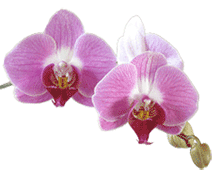Keiki's on an Orchid
Occasionally an orchid plant will bear a little plantlet off of its flower stem or pseudobulb. These little baby plants are often called Keiki's (Hawaiian for "baby"). Frequently we are asked what should be done when this happens.

Keikis are seen more frequently on Phalaenopsis, Epidendrum, and Dendrobium than on other orchids. If the mother plant is happy, forming new leaves, growths and spikes then it is fine, it is likely just in its genes to bear keikis in this way. If you would like to have a Keiki of your own to grow, hybrid Phalaenopsis bred from the species Equestris often produce such babies and are fairly easy to grow. Shown here is a young hybrid of Phal Be Tris and Ho's Little Amaglad, both of which have the species Phal Equestris in their background. This little baby plant is identical to its mother and will bear flowers that look like the mother's. Plant hormones such as KeikiGrow Plus can be applied to stimulate the growth of a keiki.

Once a Keiki has roots of 1-3 inches, it is good to repot both the mother plant and the baby. Normally we suggest planting both together in the same pot in fresh mix. When keiki's are very small they seem to do best in the same pot with the mother for the first year because the mother plant helps regulate moisture conditions in the pot. We snip off the Keiki about an inch or two down the spike (or stalk) and gently set the little plant next to the mother and encourage the roots to go downward and establish themselves in the pot. It's ok to bury a bit of the cut off flower spike with the keiki, usually we bend it straight down in an attempt to anchor the little one. Some people choose to leave the baby on the parent and both will bloom in due time which can be very pretty.

A different kind of keiki can develop at the base of the Phalaenopsis. Under the bottom leaves, along the main stem, are dormant nodes which can develop into a new growth. This type of keiki is left on the plant. We have seen cases where a Phalaenopsis completely dies back from crown rot only to sprout an entirely new shoot from the base. These growths tend to grow very quickly, fueled by the large root system of the mother plant.











